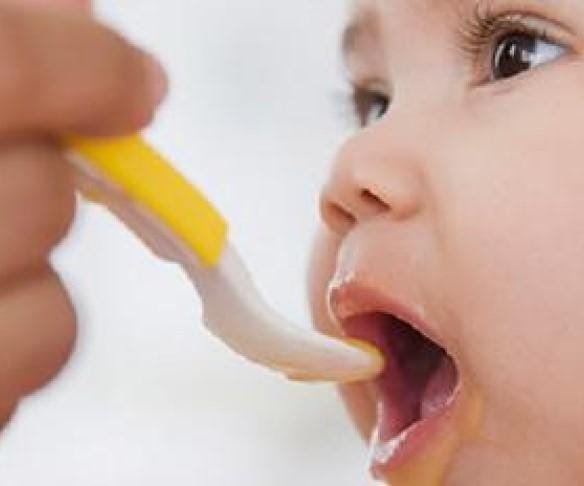If you’re introducing solid foods to your baby’s diet, then you might be wondering about different options such as baby-led weaning, spoon-feeding purees, or even a combination of both. Baby-led weaning and spoon-feeding purees are common ways to feed babies, each with their own unique benefits. Here we explain the benefits of each and how to combine finger foods and purees when feeding your baby.
Q. What is baby-led weaning?
A. Baby-led weaning is a way to introduce foods to your baby, which focuses on self-feeding. It is usually started at 6 months, not sooner and you offer your baby finger foods—that is, whole pieces of food cut into strips or pieces, which they feed themselves. Parents can also pre-load spoons for baby to self-feed purees or cereals.
Q. What is baby spoon-feeding?
A. Baby spoon-feeding is when you introduce solid foods to your baby in pureed form, such as iron fortified infant cereal or fruit and veggie purees using an infant spoon. Parents or caregivers scoop food onto the spoon and offer the spoonful to baby paying close attention to baby’s hunger and fullness cues.
Q. What are the benefits of baby-led weaning and spoon-feeding purees?
A. Baby-led weaning often emphasizes exploration – of tastes, textures, colors, and smells – as babies really use all their senses (and budding skills) to self feed. When variety is offered, it may help children accept new foods more readily. Self-feeding also supports the development of baby’s gross and fine motor skills, hand-eye coordination, and chewing.
Spoon-feeding purees helps your baby to develop oral-motor skills, while supporting the development of a wide variety of your child’s jaw movement. Spoon-fed meals gives your baby the opportunity to try a variety of puree textures (smooth, chunky, thin, thick), adapt to these different sensations, and get used to them. Eating from a spoon also helps synchronize the sucking-chewing-swallowing sequence that your baby follows during mealtimes.
Both baby led weaning and spoon feeding give your baby important nutrition when you carefully choose nutrient dense foods to offer, such as infant cereals, veggies, fruits and meats.
Q. Is baby-led weaning safe?
A. Parents and healthcare providers sometimes have concerns about the baby-led weaning approach. First is the risk of baby choking due to the advanced textures of foods the child is experiencing. Second is whether babies consume enough food and receive all the nutrients they need, particularly iron. But with careful food preparation and planning, these concerns can be alleviated. Give your baby finger foods in the correct sizes and shapes, and cook foods to make them soft. Offering your baby high-nutrient and iron-rich foods at each meal can help them to meet nutritional requirements. Including iron fortified infant cereal in recipes or by spoon feeding is another great way to provide iron.
Q. Can I combine finger foods and spoon-feeding?
A. Absolutely! Sometimes known as “baby-led feeding”, using both methods will give your child new flavors and textures to explore. Your baby gets a boost in hand-eye coordination and lots of sensory experience when eating finger foods, and learns to manipulate purees in the mouth when being fed with a spoon. Another option is to pre-load a short-handled baby spoon with puree and hand it to your baby. This way, they can explore and try feeding themselves a pureed texture.
Babies need solid sources of important nutrients such as iron and zinc in their diet. Most finger foods that babies can manipulate at an early age are soft fruit and vegetables, which are not good sources of iron or zinc. Mixing these feeding approaches, and serving your baby iron and zinc-rich purees prepared from meat, chicken, egg yolks, beans, and greens, helps your baby get the nutrients they need.
Q. What is responsive feeding?
A. Responsive feeding is a part of ALL feeding methods (and not just babies –kids too!) Instead of focusing on how much your baby eats, pay attention to their signals. When you offer your baby food, whether through finger-feeding or spoon-feeding, recognize and respond to their hunger and fullness cues in a timely manner. Don’t pressure or restrict how much they eat. That’s the foundation of responsive feeding . Your baby can’t use words to tell you they want food, or has eaten enough, but they will let you know in other ways.
Learn more about responsive feeding, and the signs whether your baby is full or signs whether your baby is hungry, here.
Source:
Sarah Smith-Simpson PhD, Gerber Principal Scientist, and developmental feeding expert





